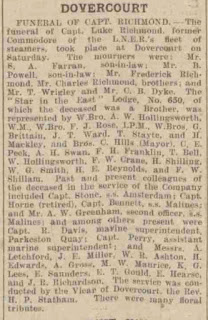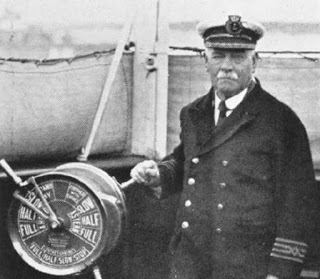
Reproduced from LNER Magazine October 1930
When he was a child, my father was told that one of his distant relatives was the captain of a ship that took the German Ambassador, Karl Max, Prince Lichnowsky out of England at the outbreak of the first world war in August 1914.
It seems likely that Luke Johnson Richmond was the relative his family had in mind.

Although the port enjoyed mixed success over the years, there was sufficient shipping trade to require an increase in capacity by the 1880s.
In 1883 Parkeston Quay (now known as Harwich International Port) was built. And one year later, at the age of 20, Luke Richmond signed up to work there.
Luke Richmond's career with the Great Eastern Railway (GER) Fleet
Instead. at the age of nineteen (1883) Luke became a Freeman of the City of London. This meant he could transport freight into London by sea without being restricted to 2-crew..
Luke signed up in 1884; became a second officer in 1888; first officer in 1895; got his masters certificate in 1899 (pictured above); and was captain of his own steamer from September 1902. And in 1903 he became Commodore of the entire GER Fleet - a post he held until retirement in June 1930.
Twenty-eight years out of the total forty-six, Richmond commanded GER steamers.
The 1915 crew list provides a comprehensive free-to-access list of crew members in all merchant navy vessels during the year. For other years a sample of crew lists have been digitised - with the National Archive selecting one in ten boxes to analyse.
Three Richmonds served in the crew of the GER steamer SS Copenhagen in 1915: Captain Luke Johnson, master of the ship; William (second son of Luke Johnson Richmond), mate; and Frederick (third son), a steward.
Copenhagen was a luxury ferry built to transport up to 320 first class passengers, and 120 second class passengers. It had a crew of 52 men, and a maximum speed of 20 knots.
Having three out of five sons on one ship was perhaps unwise.
The steamers were considered fair game by the Germans despite their civilian crew. And the attacks grew more deadly as the first world war progressed.
The war years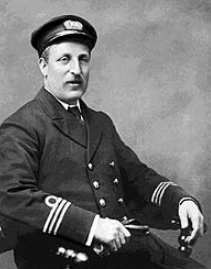 Captain Fryatt was executed by the Germans in 1916
Captain Fryatt was executed by the Germans in 1916
The Dovercourt and Harwich historical web site harwichanddovercourt.co.uk records that three GER steamers were attacked by German U-Boats in March 1915: the Brussels; the Colchester and the Wrexham.
The Wrexham managed to escape through the efforts of their crew and its master Captain Fryatt. He managed to outpace the subs, getting 16 knots out of his ship, despite its maximum official speed of 14 knots and thereby avoiding capture.
Later that month Fryatt was again ordered to surrender by a German submarine - this time when he was captain of the SS Brussels.
Instead of yielding, he tried to ram the submarine (forcing it to dive). Twenty minutes later, however, the Brussels was boarded and this time Fryatt was captured.
He endured three weeks of interrogation before he was released.
In June 1916 Fryatt was transporting Dutch refugees from the Hook of Holland to Harwich when he was attacked for a third time. He was captured and interrogated as before. But on this occasion, rather than being released, he was executed.
The Germans argued in his trial that he had chosen to ram their submarine back in 1915.
Inadvertently reinforcing a later stereotype, they also argued that they would have accepted an excuse that he had been acting under orders. Without it however, his actions were a capital offence.
Fryatt's execution provoked outrage in England. Like the execution of British nurse, Edith Cavell, it was seen as evidence of the poor behaviour of the enemy.
After the war Fryatt was returned home to Dovercourt in honour, his coffin strapped to a gun carriage.
The Great Eastern Railway line from Liverpool Street Station to Harwich was lined with mourners and a memorial was erected both in Harwich and at Liverpool Street Station.
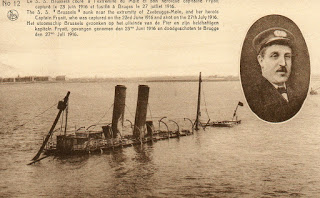
The sinking of the Steamer Copenhagen

The Steamer Copenhagen (1907) was built to transport passengers and mail between Harwich and the Hook of Holland
On 3 March 1917 the steamer Copenhagen, Luke Richmond's ship in 1915, was torpedoed, and sank with the loss of six lives.
There was no warning, or request to stop. No attempt to board.
Were Luke and his two brothers onboard? It's difficult to know.
Just as Fryatt was moving from ship to ship, so might Luke Richmond and his brothers have been.
At the start of the war, the Copenhagen was used to carry Belgian refugees. Subsequently it was a troop carrier but ultimately from January 1916 it was turned into a hospital ship. It brought wounded soldiers back to Harwich to the hospitals which had been established there at the start of the war.
The Dovercourt and Harwich history website provides details of these hospitals and a photograph (shown below) of nurses from a GER managed hospital in December 1914.
The nurses were leaving the Grange in a procession to celebrate Christmas with the troops. At the front of the procession a young Captain - who certainly resembles Luke Richmond - is shown leading the way.
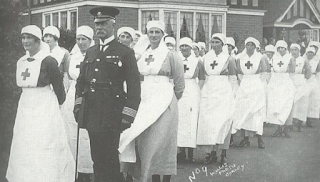
Is this Luke Richmond leading nurses to a Christmas celebration in December 1914?
Three of the soldiers listed as being crew with Luke Richmond and his brothers in 1915 died when the Copenhagen sank.
Prince Lichnowsky
He travelled on the SS St Petersburg, another GER ship.
I wrote to the Maritime History Archivist at the Memorial University of Newfoundland who keeps records of the masters of all ships to see if he could identify the master of the St Petersburg on this journey.
He told me that when they went to their records, they discovered that the GER used a special type of crew agreement where all crew members working on different vessels for a particular company are listed together.
The GER could move masters and crew between ships as required. Just as seems to be the case for Captain Fryatt in 1915-16.
The archivist confirmed that Luke Richmond was one of the nine masters registered with the GER fleet.
He also suggested that the ships log held in the National Archive in Kew, might give more definitive proof.
Sadly this lead turned out to be a dead end. The ships log is only signed by one of the masters every six months rather than every journey. The master who signed the log for the six months July to December 1914 was William Dale.
The verdict
Luke Johnson was certainly in the right place at the right time but seems impossible to know whether he captained the ship.
As commodore, Richmond would have been involved at least. Lichnowsky's successful repatriation would have been a priority for Great Britain and it seems likely that this would warrant the close attention of the Commodore of the Fleet.
Tensions in August 1914 were rising fast, and the North Sea, not Normandy was where fighting broke out first.
On 3rd August 1914.the German ferry ship Königin Luise was requisitioned as a mine layer.
She was disguised in the black, buff, and yellow colours of the steamers of the Great Eastern Railway, and sent out to sea to lay mines.
There can be little doubt, given the choice of colours, that the intention was to mine areas where the Great Eastern Railway fleet were active. The timing and choice of a similar ship to the GER fleet also seems significant.
On 4th August 1914 Königin Luise was seen "throwing objects into the sea" off the coast of Holland along the path that the ambassador would have travelled. These were presumed to be mines.
British destroyers Lance and Landrail engaged, firing what is believed to be the first shot in the first world war.
The German Captain responded by scuttling their ship rather than allowing it to be captured.
Two days later the papers were full of rumours of an imminent and major sea battle. The Royal Navy was kept busy seizing German boats in British Ports.
And at this moment, the SS Copenhagen set sail to the Hook of Holland with the German ambassador on board.
Luke Johnson died on 14th April 1936. Frederick and his other living brothers attended his funeral. William died in 1931. The three brothers, all on one ship, survived the war.
